Bronze Snake: Expanding into China - Business Strategy Report
VerifiedAdded on 2022/10/16
|11
|2886
|474
Report
AI Summary
This report examines Bronze Snake, an Australian fashion retailer, and its strategy for expanding into the Chinese market. It begins with background information on the company and the rationale for choosing China as a target market, highlighting the country's economic potential and consumer demographics. The report analyzes the product choice (clothing for young adults) and discusses the application of PESTLE analysis to understand the political, economic, social, technological, legal, and environmental factors influencing the business environment in China. It then explores strategic design theories such as segmentation, targeting, and positioning (STP), the 4Ps of marketing, cultural theories like Hofstede's dimensions, and market entry theories, emphasizing the importance of adapting strategies to the local context. The chosen international business strategy is a joint venture, and the report discusses its strategic implications, resource requirements, and potential risks, including cultural differences and market competition. The report concludes by emphasizing the importance of financial resources, skilled labor, and effective leadership in implementing the expansion strategy.
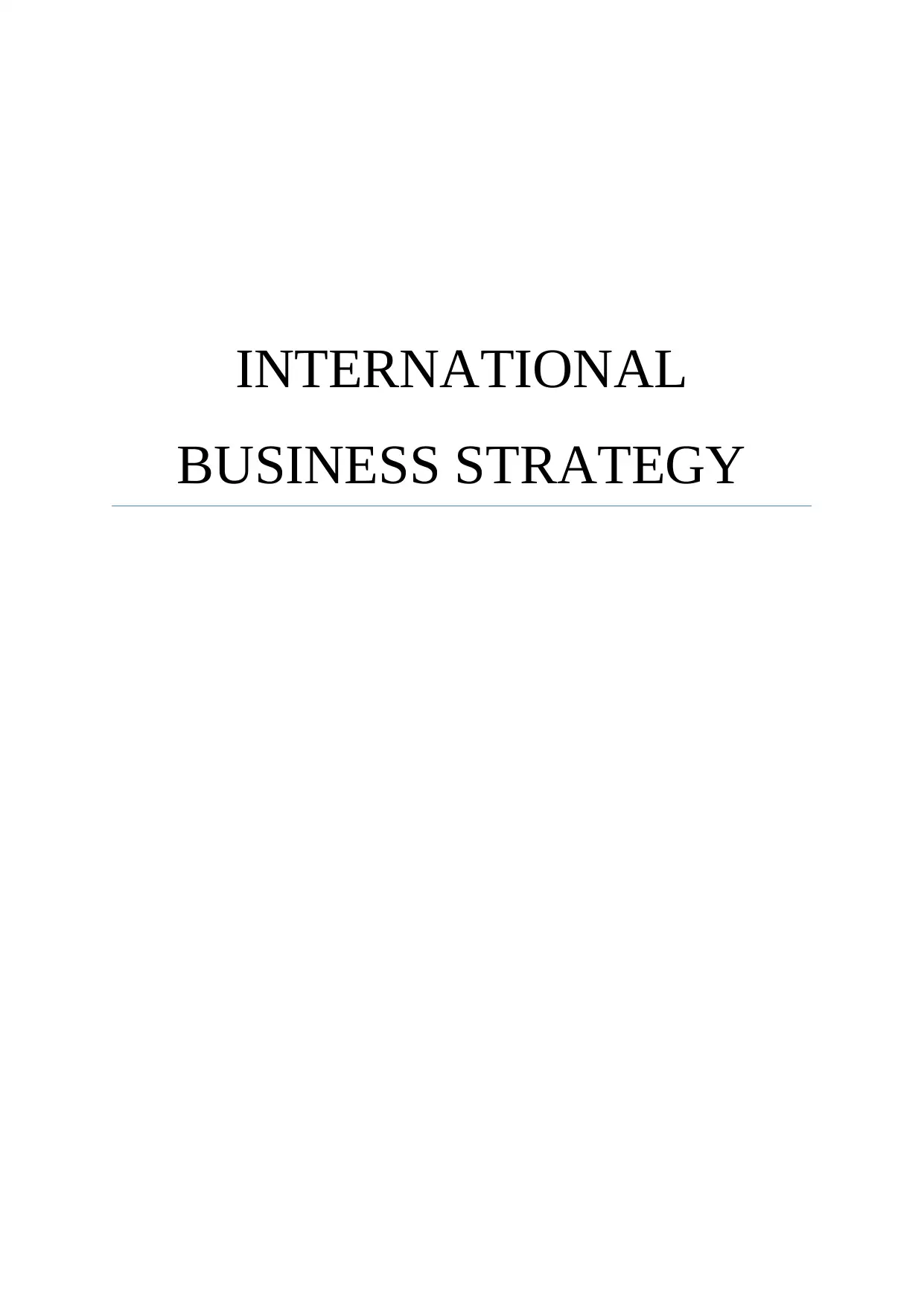
INTERNATIONAL
BUSINESS STRATEGY
BUSINESS STRATEGY
Paraphrase This Document
Need a fresh take? Get an instant paraphrase of this document with our AI Paraphraser
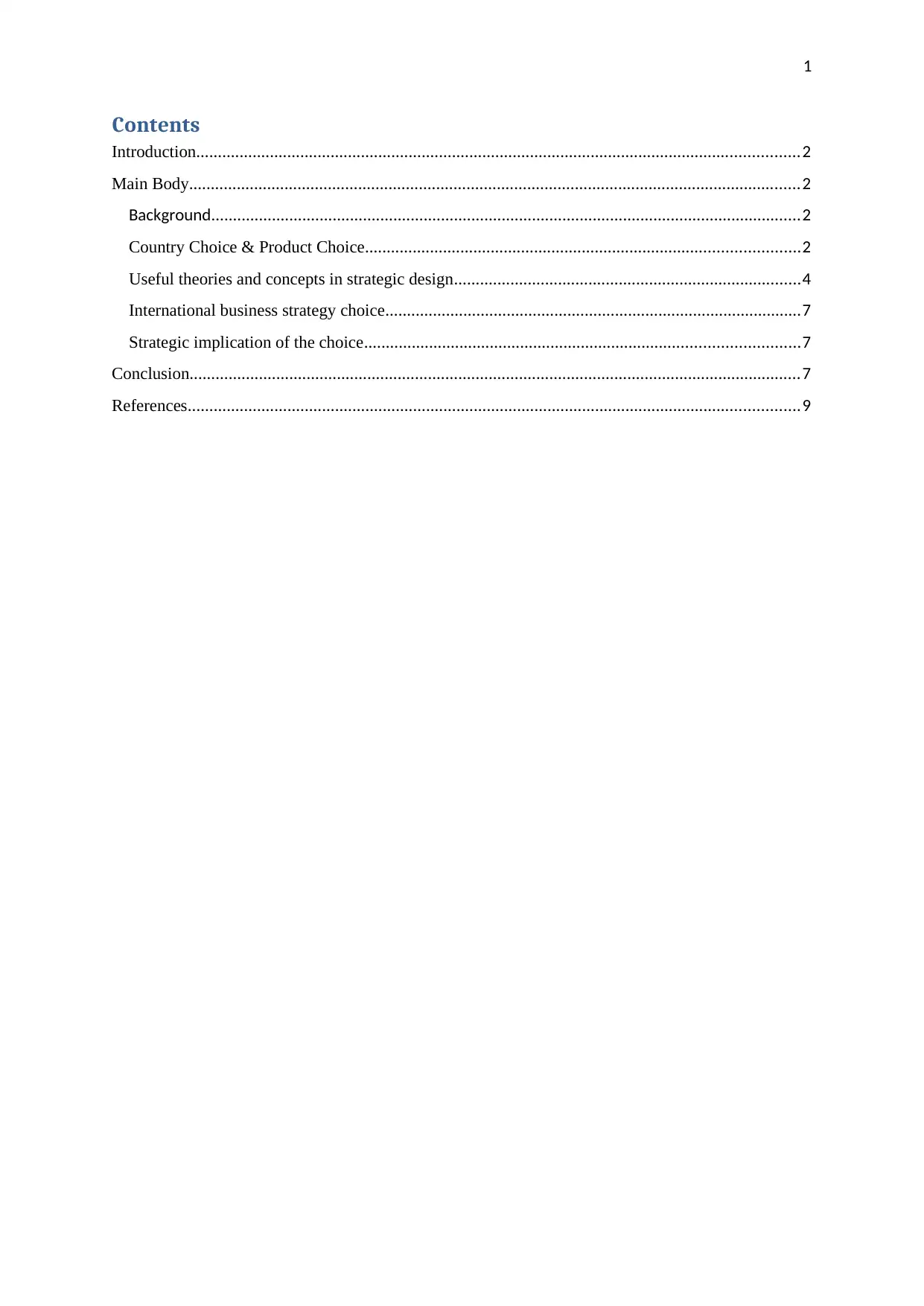
1
Contents
Introduction...........................................................................................................................................2
Main Body.............................................................................................................................................2
Background........................................................................................................................................2
Country Choice & Product Choice....................................................................................................2
Useful theories and concepts in strategic design................................................................................4
International business strategy choice................................................................................................7
Strategic implication of the choice....................................................................................................7
Conclusion.............................................................................................................................................7
References.............................................................................................................................................9
Contents
Introduction...........................................................................................................................................2
Main Body.............................................................................................................................................2
Background........................................................................................................................................2
Country Choice & Product Choice....................................................................................................2
Useful theories and concepts in strategic design................................................................................4
International business strategy choice................................................................................................7
Strategic implication of the choice....................................................................................................7
Conclusion.............................................................................................................................................7
References.............................................................................................................................................9
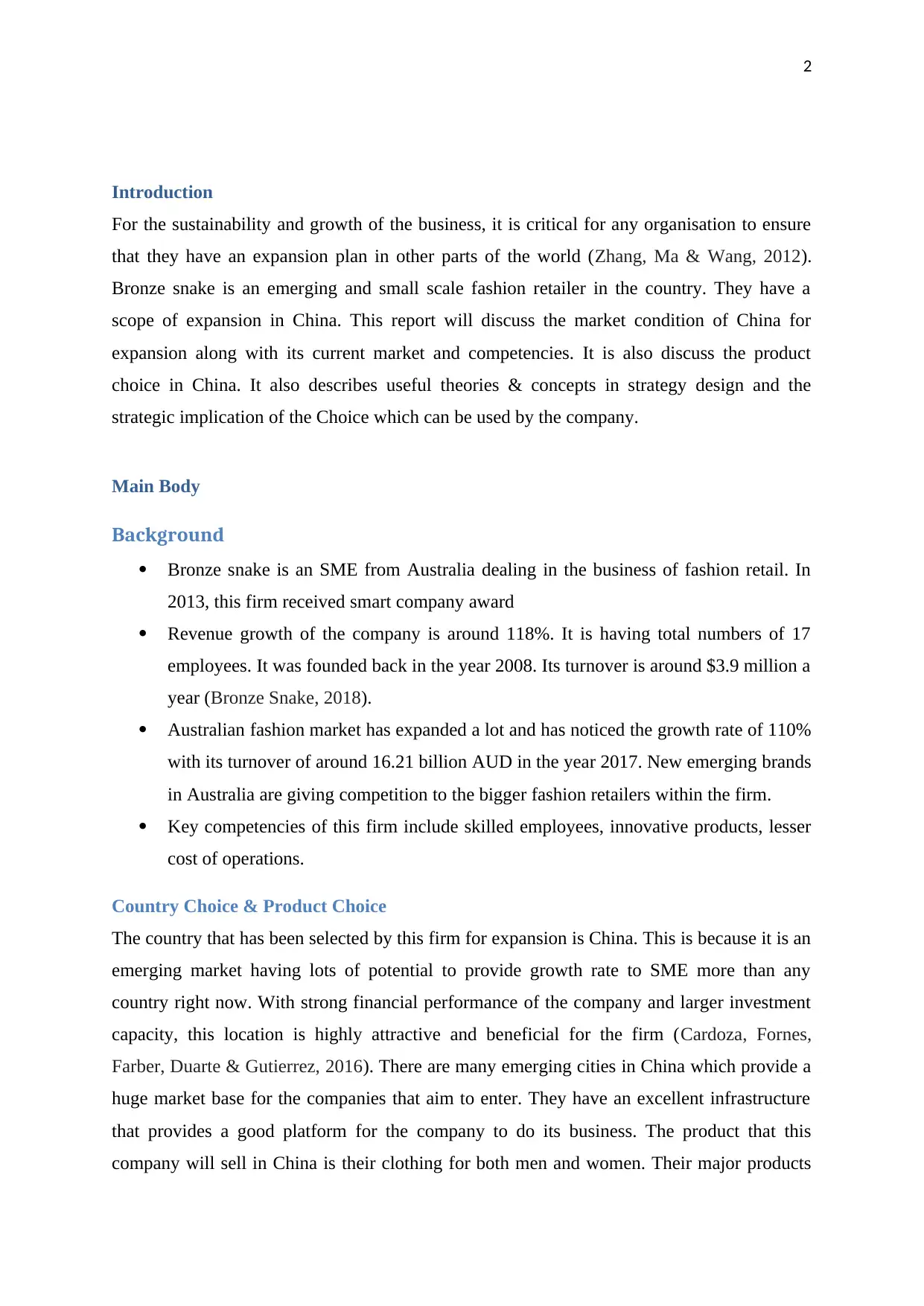
2
Introduction
For the sustainability and growth of the business, it is critical for any organisation to ensure
that they have an expansion plan in other parts of the world (Zhang, Ma & Wang, 2012).
Bronze snake is an emerging and small scale fashion retailer in the country. They have a
scope of expansion in China. This report will discuss the market condition of China for
expansion along with its current market and competencies. It is also discuss the product
choice in China. It also describes useful theories & concepts in strategy design and the
strategic implication of the Choice which can be used by the company.
Main Body
Background
Bronze snake is an SME from Australia dealing in the business of fashion retail. In
2013, this firm received smart company award
Revenue growth of the company is around 118%. It is having total numbers of 17
employees. It was founded back in the year 2008. Its turnover is around $3.9 million a
year (Bronze Snake, 2018).
Australian fashion market has expanded a lot and has noticed the growth rate of 110%
with its turnover of around 16.21 billion AUD in the year 2017. New emerging brands
in Australia are giving competition to the bigger fashion retailers within the firm.
Key competencies of this firm include skilled employees, innovative products, lesser
cost of operations.
Country Choice & Product Choice
The country that has been selected by this firm for expansion is China. This is because it is an
emerging market having lots of potential to provide growth rate to SME more than any
country right now. With strong financial performance of the company and larger investment
capacity, this location is highly attractive and beneficial for the firm (Cardoza, Fornes,
Farber, Duarte & Gutierrez, 2016). There are many emerging cities in China which provide a
huge market base for the companies that aim to enter. They have an excellent infrastructure
that provides a good platform for the company to do its business. The product that this
company will sell in China is their clothing for both men and women. Their major products
Introduction
For the sustainability and growth of the business, it is critical for any organisation to ensure
that they have an expansion plan in other parts of the world (Zhang, Ma & Wang, 2012).
Bronze snake is an emerging and small scale fashion retailer in the country. They have a
scope of expansion in China. This report will discuss the market condition of China for
expansion along with its current market and competencies. It is also discuss the product
choice in China. It also describes useful theories & concepts in strategy design and the
strategic implication of the Choice which can be used by the company.
Main Body
Background
Bronze snake is an SME from Australia dealing in the business of fashion retail. In
2013, this firm received smart company award
Revenue growth of the company is around 118%. It is having total numbers of 17
employees. It was founded back in the year 2008. Its turnover is around $3.9 million a
year (Bronze Snake, 2018).
Australian fashion market has expanded a lot and has noticed the growth rate of 110%
with its turnover of around 16.21 billion AUD in the year 2017. New emerging brands
in Australia are giving competition to the bigger fashion retailers within the firm.
Key competencies of this firm include skilled employees, innovative products, lesser
cost of operations.
Country Choice & Product Choice
The country that has been selected by this firm for expansion is China. This is because it is an
emerging market having lots of potential to provide growth rate to SME more than any
country right now. With strong financial performance of the company and larger investment
capacity, this location is highly attractive and beneficial for the firm (Cardoza, Fornes,
Farber, Duarte & Gutierrez, 2016). There are many emerging cities in China which provide a
huge market base for the companies that aim to enter. They have an excellent infrastructure
that provides a good platform for the company to do its business. The product that this
company will sell in China is their clothing for both men and women. Their major products
⊘ This is a preview!⊘
Do you want full access?
Subscribe today to unlock all pages.

Trusted by 1+ million students worldwide
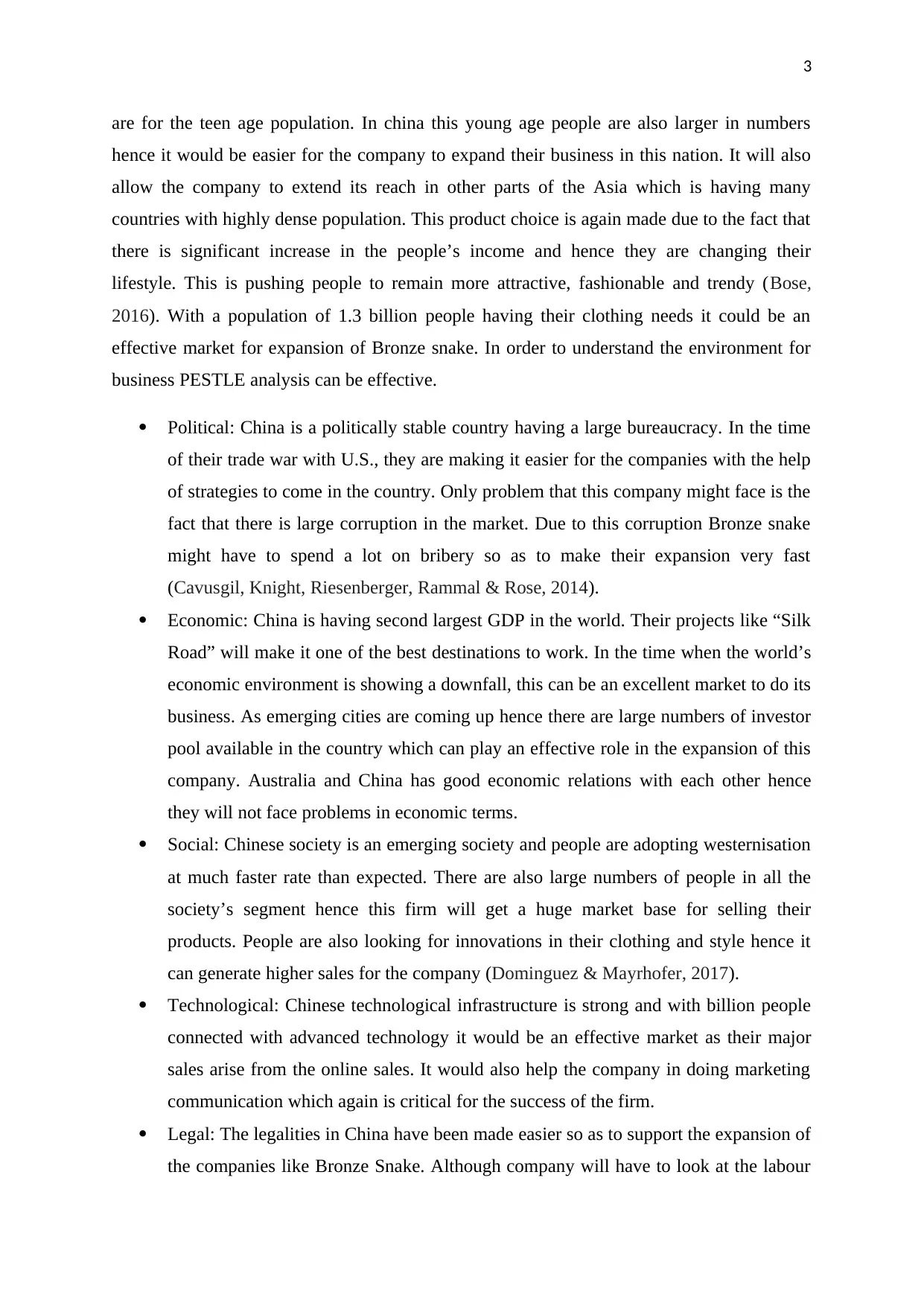
3
are for the teen age population. In china this young age people are also larger in numbers
hence it would be easier for the company to expand their business in this nation. It will also
allow the company to extend its reach in other parts of the Asia which is having many
countries with highly dense population. This product choice is again made due to the fact that
there is significant increase in the people’s income and hence they are changing their
lifestyle. This is pushing people to remain more attractive, fashionable and trendy (Bose,
2016). With a population of 1.3 billion people having their clothing needs it could be an
effective market for expansion of Bronze snake. In order to understand the environment for
business PESTLE analysis can be effective.
Political: China is a politically stable country having a large bureaucracy. In the time
of their trade war with U.S., they are making it easier for the companies with the help
of strategies to come in the country. Only problem that this company might face is the
fact that there is large corruption in the market. Due to this corruption Bronze snake
might have to spend a lot on bribery so as to make their expansion very fast
(Cavusgil, Knight, Riesenberger, Rammal & Rose, 2014).
Economic: China is having second largest GDP in the world. Their projects like “Silk
Road” will make it one of the best destinations to work. In the time when the world’s
economic environment is showing a downfall, this can be an excellent market to do its
business. As emerging cities are coming up hence there are large numbers of investor
pool available in the country which can play an effective role in the expansion of this
company. Australia and China has good economic relations with each other hence
they will not face problems in economic terms.
Social: Chinese society is an emerging society and people are adopting westernisation
at much faster rate than expected. There are also large numbers of people in all the
society’s segment hence this firm will get a huge market base for selling their
products. People are also looking for innovations in their clothing and style hence it
can generate higher sales for the company (Dominguez & Mayrhofer, 2017).
Technological: Chinese technological infrastructure is strong and with billion people
connected with advanced technology it would be an effective market as their major
sales arise from the online sales. It would also help the company in doing marketing
communication which again is critical for the success of the firm.
Legal: The legalities in China have been made easier so as to support the expansion of
the companies like Bronze Snake. Although company will have to look at the labour
are for the teen age population. In china this young age people are also larger in numbers
hence it would be easier for the company to expand their business in this nation. It will also
allow the company to extend its reach in other parts of the Asia which is having many
countries with highly dense population. This product choice is again made due to the fact that
there is significant increase in the people’s income and hence they are changing their
lifestyle. This is pushing people to remain more attractive, fashionable and trendy (Bose,
2016). With a population of 1.3 billion people having their clothing needs it could be an
effective market for expansion of Bronze snake. In order to understand the environment for
business PESTLE analysis can be effective.
Political: China is a politically stable country having a large bureaucracy. In the time
of their trade war with U.S., they are making it easier for the companies with the help
of strategies to come in the country. Only problem that this company might face is the
fact that there is large corruption in the market. Due to this corruption Bronze snake
might have to spend a lot on bribery so as to make their expansion very fast
(Cavusgil, Knight, Riesenberger, Rammal & Rose, 2014).
Economic: China is having second largest GDP in the world. Their projects like “Silk
Road” will make it one of the best destinations to work. In the time when the world’s
economic environment is showing a downfall, this can be an excellent market to do its
business. As emerging cities are coming up hence there are large numbers of investor
pool available in the country which can play an effective role in the expansion of this
company. Australia and China has good economic relations with each other hence
they will not face problems in economic terms.
Social: Chinese society is an emerging society and people are adopting westernisation
at much faster rate than expected. There are also large numbers of people in all the
society’s segment hence this firm will get a huge market base for selling their
products. People are also looking for innovations in their clothing and style hence it
can generate higher sales for the company (Dominguez & Mayrhofer, 2017).
Technological: Chinese technological infrastructure is strong and with billion people
connected with advanced technology it would be an effective market as their major
sales arise from the online sales. It would also help the company in doing marketing
communication which again is critical for the success of the firm.
Legal: The legalities in China have been made easier so as to support the expansion of
the companies like Bronze Snake. Although company will have to look at the labour
Paraphrase This Document
Need a fresh take? Get an instant paraphrase of this document with our AI Paraphraser
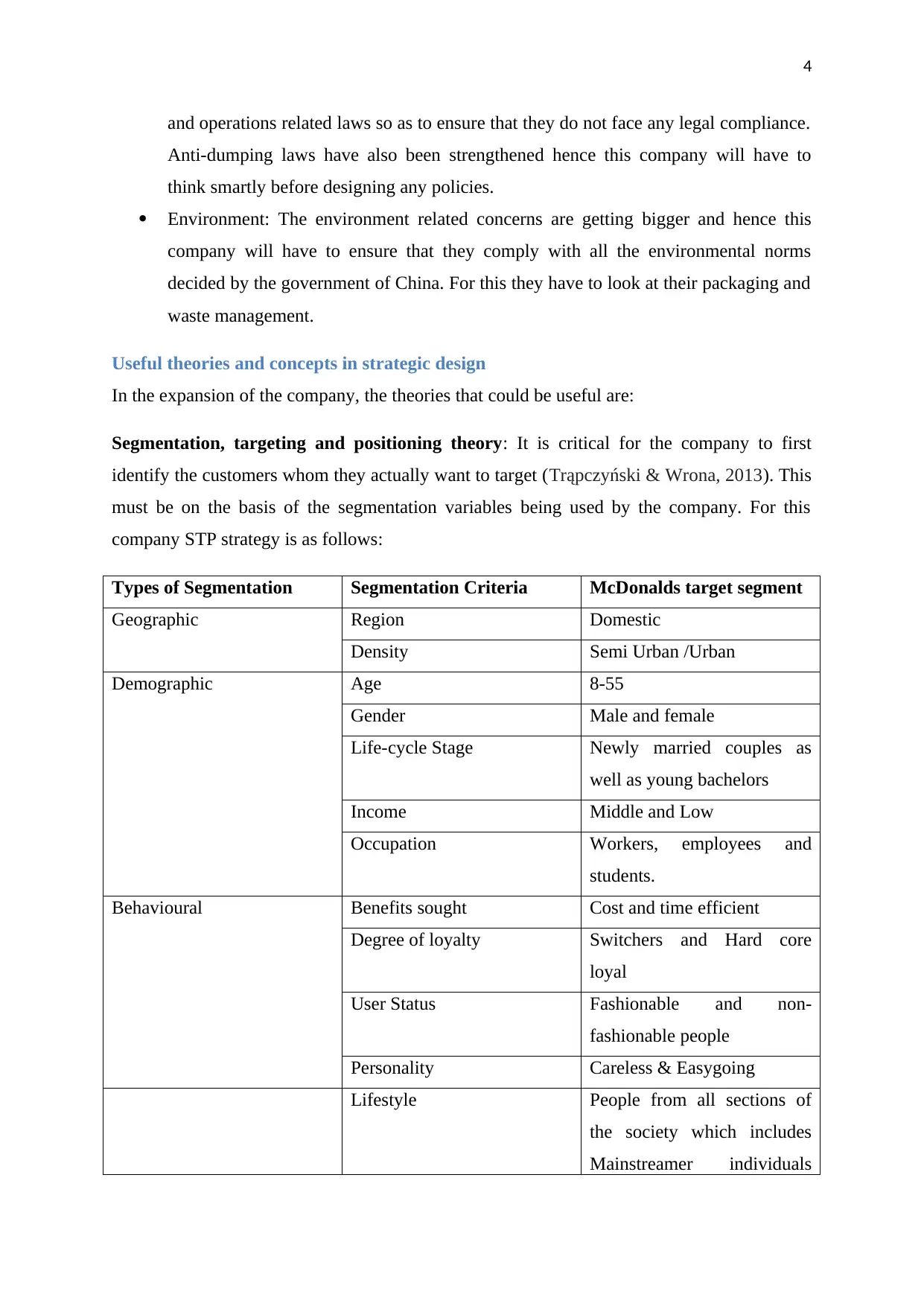
4
and operations related laws so as to ensure that they do not face any legal compliance.
Anti-dumping laws have also been strengthened hence this company will have to
think smartly before designing any policies.
Environment: The environment related concerns are getting bigger and hence this
company will have to ensure that they comply with all the environmental norms
decided by the government of China. For this they have to look at their packaging and
waste management.
Useful theories and concepts in strategic design
In the expansion of the company, the theories that could be useful are:
Segmentation, targeting and positioning theory: It is critical for the company to first
identify the customers whom they actually want to target (Trąpczyński & Wrona, 2013). This
must be on the basis of the segmentation variables being used by the company. For this
company STP strategy is as follows:
Types of Segmentation Segmentation Criteria McDonalds target segment
Geographic Region Domestic
Density Semi Urban /Urban
Demographic Age 8-55
Gender Male and female
Life-cycle Stage Newly married couples as
well as young bachelors
Income Middle and Low
Occupation Workers, employees and
students.
Behavioural Benefits sought Cost and time efficient
Degree of loyalty Switchers and Hard core
loyal
User Status Fashionable and non-
fashionable people
Personality Careless & Easygoing
Lifestyle People from all sections of
the society which includes
Mainstreamer individuals
and operations related laws so as to ensure that they do not face any legal compliance.
Anti-dumping laws have also been strengthened hence this company will have to
think smartly before designing any policies.
Environment: The environment related concerns are getting bigger and hence this
company will have to ensure that they comply with all the environmental norms
decided by the government of China. For this they have to look at their packaging and
waste management.
Useful theories and concepts in strategic design
In the expansion of the company, the theories that could be useful are:
Segmentation, targeting and positioning theory: It is critical for the company to first
identify the customers whom they actually want to target (Trąpczyński & Wrona, 2013). This
must be on the basis of the segmentation variables being used by the company. For this
company STP strategy is as follows:
Types of Segmentation Segmentation Criteria McDonalds target segment
Geographic Region Domestic
Density Semi Urban /Urban
Demographic Age 8-55
Gender Male and female
Life-cycle Stage Newly married couples as
well as young bachelors
Income Middle and Low
Occupation Workers, employees and
students.
Behavioural Benefits sought Cost and time efficient
Degree of loyalty Switchers and Hard core
loyal
User Status Fashionable and non-
fashionable people
Personality Careless & Easygoing
Lifestyle People from all sections of
the society which includes
Mainstreamer individuals
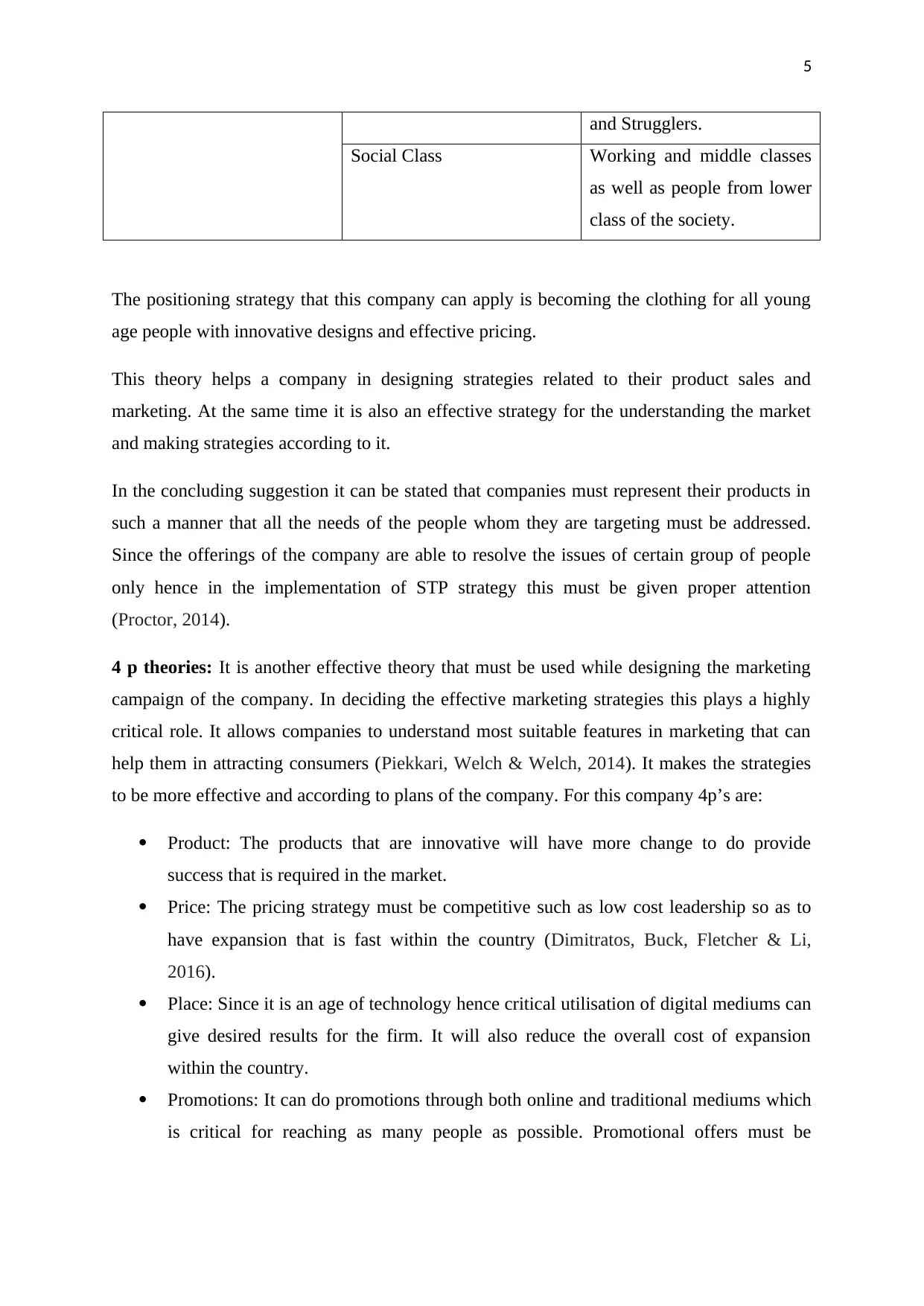
5
and Strugglers.
Social Class Working and middle classes
as well as people from lower
class of the society.
The positioning strategy that this company can apply is becoming the clothing for all young
age people with innovative designs and effective pricing.
This theory helps a company in designing strategies related to their product sales and
marketing. At the same time it is also an effective strategy for the understanding the market
and making strategies according to it.
In the concluding suggestion it can be stated that companies must represent their products in
such a manner that all the needs of the people whom they are targeting must be addressed.
Since the offerings of the company are able to resolve the issues of certain group of people
only hence in the implementation of STP strategy this must be given proper attention
(Proctor, 2014).
4 p theories: It is another effective theory that must be used while designing the marketing
campaign of the company. In deciding the effective marketing strategies this plays a highly
critical role. It allows companies to understand most suitable features in marketing that can
help them in attracting consumers (Piekkari, Welch & Welch, 2014). It makes the strategies
to be more effective and according to plans of the company. For this company 4p’s are:
Product: The products that are innovative will have more change to do provide
success that is required in the market.
Price: The pricing strategy must be competitive such as low cost leadership so as to
have expansion that is fast within the country (Dimitratos, Buck, Fletcher & Li,
2016).
Place: Since it is an age of technology hence critical utilisation of digital mediums can
give desired results for the firm. It will also reduce the overall cost of expansion
within the country.
Promotions: It can do promotions through both online and traditional mediums which
is critical for reaching as many people as possible. Promotional offers must be
and Strugglers.
Social Class Working and middle classes
as well as people from lower
class of the society.
The positioning strategy that this company can apply is becoming the clothing for all young
age people with innovative designs and effective pricing.
This theory helps a company in designing strategies related to their product sales and
marketing. At the same time it is also an effective strategy for the understanding the market
and making strategies according to it.
In the concluding suggestion it can be stated that companies must represent their products in
such a manner that all the needs of the people whom they are targeting must be addressed.
Since the offerings of the company are able to resolve the issues of certain group of people
only hence in the implementation of STP strategy this must be given proper attention
(Proctor, 2014).
4 p theories: It is another effective theory that must be used while designing the marketing
campaign of the company. In deciding the effective marketing strategies this plays a highly
critical role. It allows companies to understand most suitable features in marketing that can
help them in attracting consumers (Piekkari, Welch & Welch, 2014). It makes the strategies
to be more effective and according to plans of the company. For this company 4p’s are:
Product: The products that are innovative will have more change to do provide
success that is required in the market.
Price: The pricing strategy must be competitive such as low cost leadership so as to
have expansion that is fast within the country (Dimitratos, Buck, Fletcher & Li,
2016).
Place: Since it is an age of technology hence critical utilisation of digital mediums can
give desired results for the firm. It will also reduce the overall cost of expansion
within the country.
Promotions: It can do promotions through both online and traditional mediums which
is critical for reaching as many people as possible. Promotional offers must be
⊘ This is a preview!⊘
Do you want full access?
Subscribe today to unlock all pages.

Trusted by 1+ million students worldwide
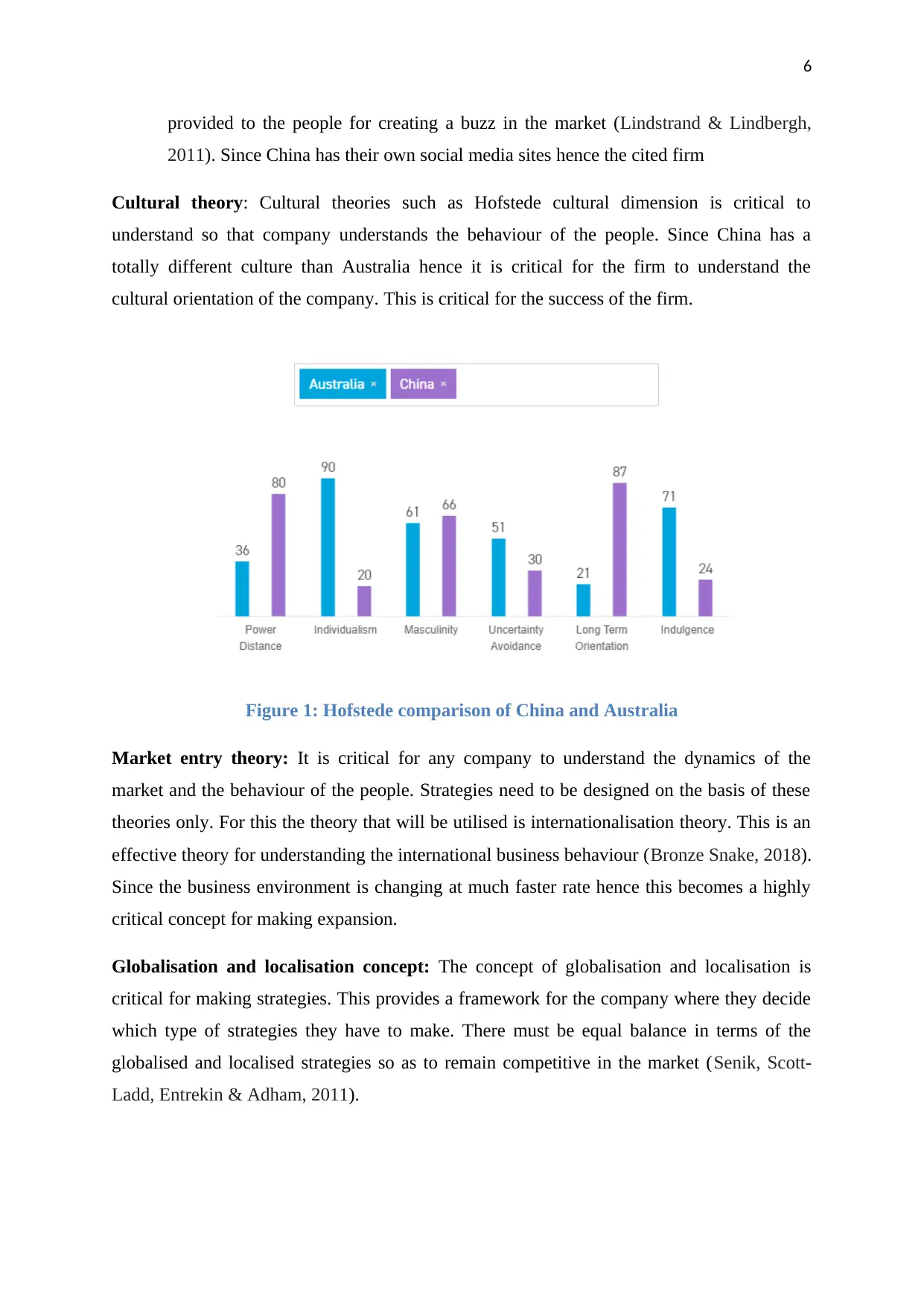
6
provided to the people for creating a buzz in the market (Lindstrand & Lindbergh,
2011). Since China has their own social media sites hence the cited firm
Cultural theory: Cultural theories such as Hofstede cultural dimension is critical to
understand so that company understands the behaviour of the people. Since China has a
totally different culture than Australia hence it is critical for the firm to understand the
cultural orientation of the company. This is critical for the success of the firm.
Figure 1: Hofstede comparison of China and Australia
Market entry theory: It is critical for any company to understand the dynamics of the
market and the behaviour of the people. Strategies need to be designed on the basis of these
theories only. For this the theory that will be utilised is internationalisation theory. This is an
effective theory for understanding the international business behaviour (Bronze Snake, 2018).
Since the business environment is changing at much faster rate hence this becomes a highly
critical concept for making expansion.
Globalisation and localisation concept: The concept of globalisation and localisation is
critical for making strategies. This provides a framework for the company where they decide
which type of strategies they have to make. There must be equal balance in terms of the
globalised and localised strategies so as to remain competitive in the market (Senik, Scott-
Ladd, Entrekin & Adham, 2011).
provided to the people for creating a buzz in the market (Lindstrand & Lindbergh,
2011). Since China has their own social media sites hence the cited firm
Cultural theory: Cultural theories such as Hofstede cultural dimension is critical to
understand so that company understands the behaviour of the people. Since China has a
totally different culture than Australia hence it is critical for the firm to understand the
cultural orientation of the company. This is critical for the success of the firm.
Figure 1: Hofstede comparison of China and Australia
Market entry theory: It is critical for any company to understand the dynamics of the
market and the behaviour of the people. Strategies need to be designed on the basis of these
theories only. For this the theory that will be utilised is internationalisation theory. This is an
effective theory for understanding the international business behaviour (Bronze Snake, 2018).
Since the business environment is changing at much faster rate hence this becomes a highly
critical concept for making expansion.
Globalisation and localisation concept: The concept of globalisation and localisation is
critical for making strategies. This provides a framework for the company where they decide
which type of strategies they have to make. There must be equal balance in terms of the
globalised and localised strategies so as to remain competitive in the market (Senik, Scott-
Ladd, Entrekin & Adham, 2011).
Paraphrase This Document
Need a fresh take? Get an instant paraphrase of this document with our AI Paraphraser
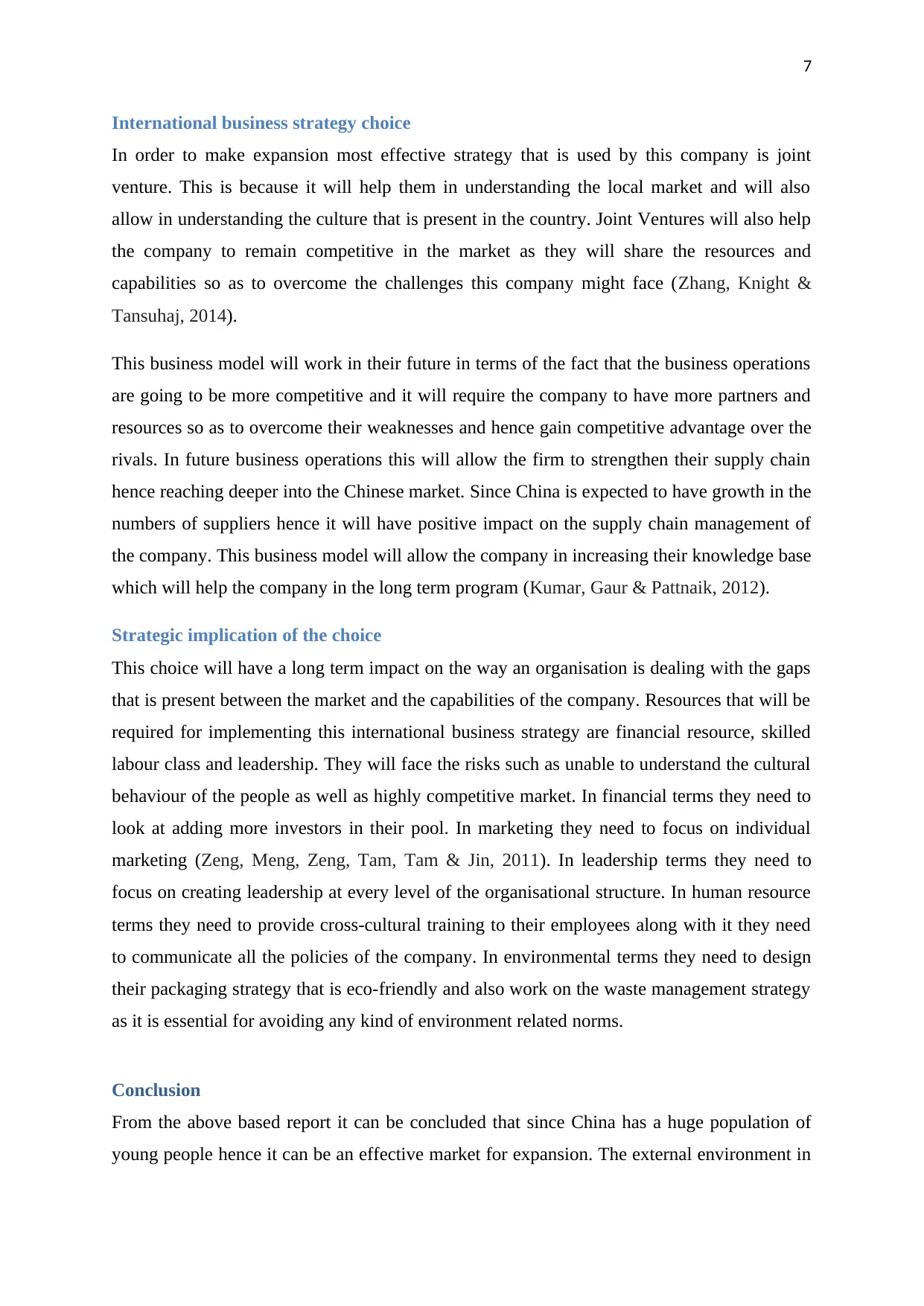
7
International business strategy choice
In order to make expansion most effective strategy that is used by this company is joint
venture. This is because it will help them in understanding the local market and will also
allow in understanding the culture that is present in the country. Joint Ventures will also help
the company to remain competitive in the market as they will share the resources and
capabilities so as to overcome the challenges this company might face (Zhang, Knight &
Tansuhaj, 2014).
This business model will work in their future in terms of the fact that the business operations
are going to be more competitive and it will require the company to have more partners and
resources so as to overcome their weaknesses and hence gain competitive advantage over the
rivals. In future business operations this will allow the firm to strengthen their supply chain
hence reaching deeper into the Chinese market. Since China is expected to have growth in the
numbers of suppliers hence it will have positive impact on the supply chain management of
the company. This business model will allow the company in increasing their knowledge base
which will help the company in the long term program (Kumar, Gaur & Pattnaik, 2012).
Strategic implication of the choice
This choice will have a long term impact on the way an organisation is dealing with the gaps
that is present between the market and the capabilities of the company. Resources that will be
required for implementing this international business strategy are financial resource, skilled
labour class and leadership. They will face the risks such as unable to understand the cultural
behaviour of the people as well as highly competitive market. In financial terms they need to
look at adding more investors in their pool. In marketing they need to focus on individual
marketing (Zeng, Meng, Zeng, Tam, Tam & Jin, 2011). In leadership terms they need to
focus on creating leadership at every level of the organisational structure. In human resource
terms they need to provide cross-cultural training to their employees along with it they need
to communicate all the policies of the company. In environmental terms they need to design
their packaging strategy that is eco-friendly and also work on the waste management strategy
as it is essential for avoiding any kind of environment related norms.
Conclusion
From the above based report it can be concluded that since China has a huge population of
young people hence it can be an effective market for expansion. The external environment in
International business strategy choice
In order to make expansion most effective strategy that is used by this company is joint
venture. This is because it will help them in understanding the local market and will also
allow in understanding the culture that is present in the country. Joint Ventures will also help
the company to remain competitive in the market as they will share the resources and
capabilities so as to overcome the challenges this company might face (Zhang, Knight &
Tansuhaj, 2014).
This business model will work in their future in terms of the fact that the business operations
are going to be more competitive and it will require the company to have more partners and
resources so as to overcome their weaknesses and hence gain competitive advantage over the
rivals. In future business operations this will allow the firm to strengthen their supply chain
hence reaching deeper into the Chinese market. Since China is expected to have growth in the
numbers of suppliers hence it will have positive impact on the supply chain management of
the company. This business model will allow the company in increasing their knowledge base
which will help the company in the long term program (Kumar, Gaur & Pattnaik, 2012).
Strategic implication of the choice
This choice will have a long term impact on the way an organisation is dealing with the gaps
that is present between the market and the capabilities of the company. Resources that will be
required for implementing this international business strategy are financial resource, skilled
labour class and leadership. They will face the risks such as unable to understand the cultural
behaviour of the people as well as highly competitive market. In financial terms they need to
look at adding more investors in their pool. In marketing they need to focus on individual
marketing (Zeng, Meng, Zeng, Tam, Tam & Jin, 2011). In leadership terms they need to
focus on creating leadership at every level of the organisational structure. In human resource
terms they need to provide cross-cultural training to their employees along with it they need
to communicate all the policies of the company. In environmental terms they need to design
their packaging strategy that is eco-friendly and also work on the waste management strategy
as it is essential for avoiding any kind of environment related norms.
Conclusion
From the above based report it can be concluded that since China has a huge population of
young people hence it can be an effective market for expansion. The external environment in
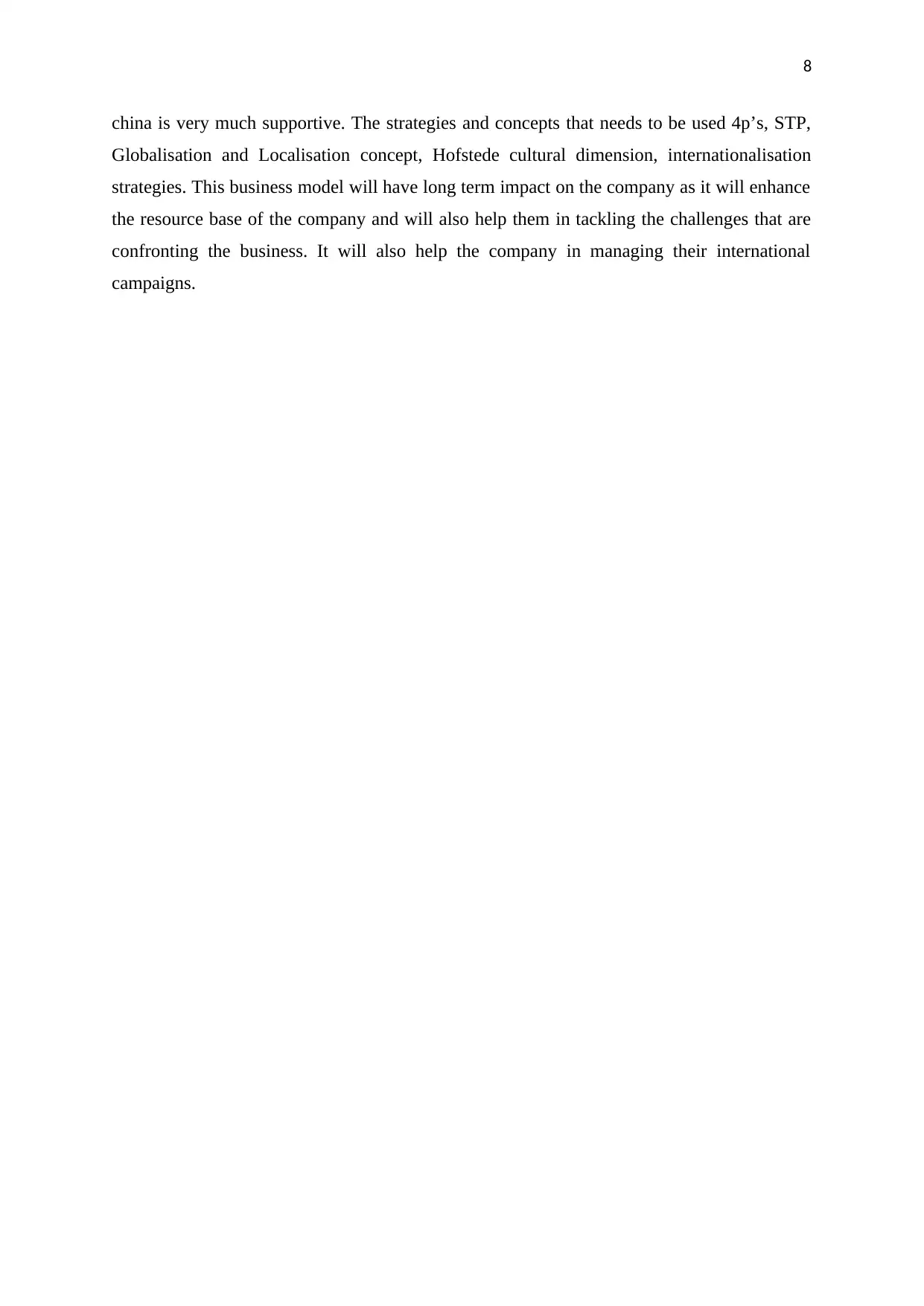
8
china is very much supportive. The strategies and concepts that needs to be used 4p’s, STP,
Globalisation and Localisation concept, Hofstede cultural dimension, internationalisation
strategies. This business model will have long term impact on the company as it will enhance
the resource base of the company and will also help them in tackling the challenges that are
confronting the business. It will also help the company in managing their international
campaigns.
china is very much supportive. The strategies and concepts that needs to be used 4p’s, STP,
Globalisation and Localisation concept, Hofstede cultural dimension, internationalisation
strategies. This business model will have long term impact on the company as it will enhance
the resource base of the company and will also help them in tackling the challenges that are
confronting the business. It will also help the company in managing their international
campaigns.
⊘ This is a preview!⊘
Do you want full access?
Subscribe today to unlock all pages.

Trusted by 1+ million students worldwide
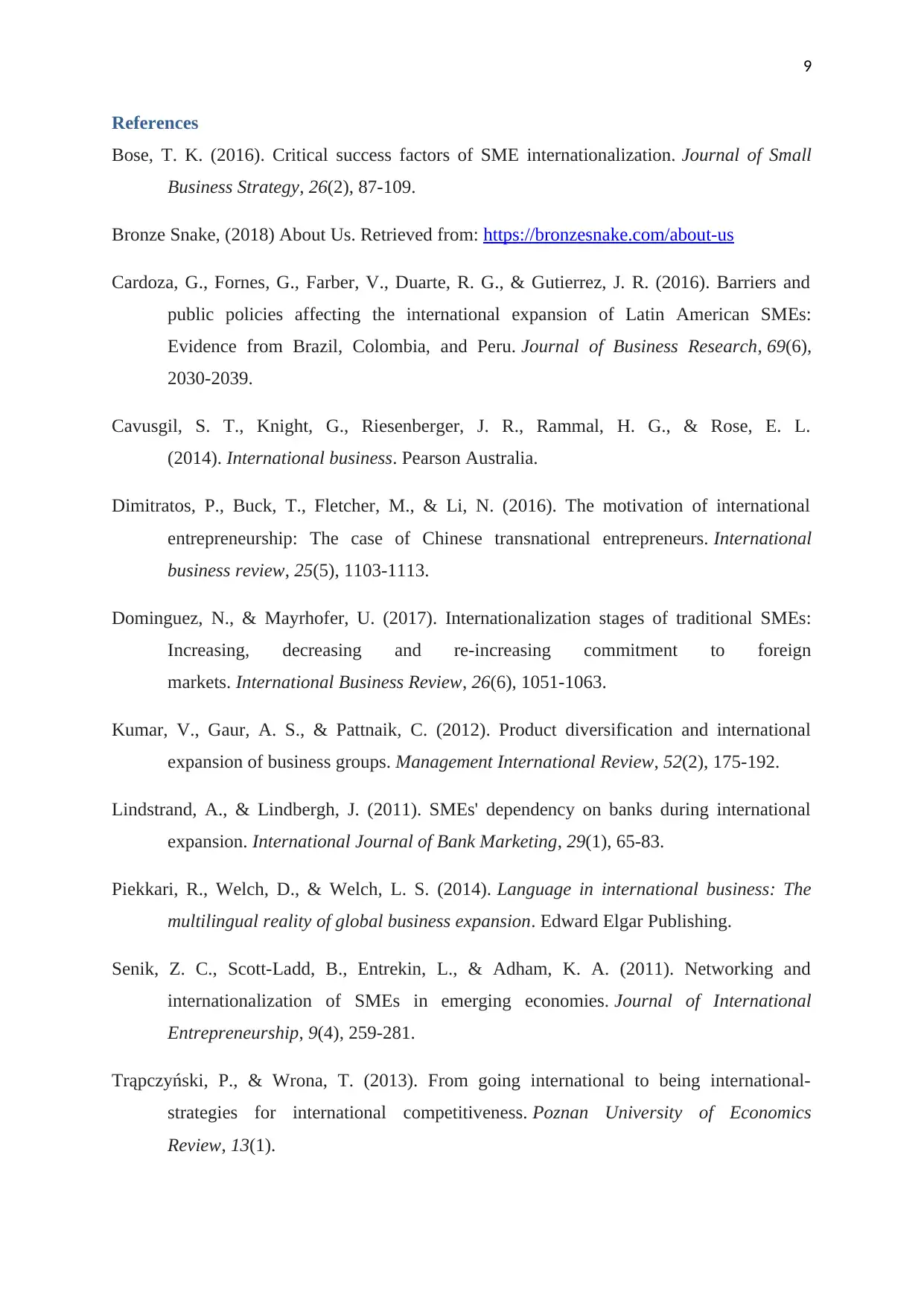
9
References
Bose, T. K. (2016). Critical success factors of SME internationalization. Journal of Small
Business Strategy, 26(2), 87-109.
Bronze Snake, (2018) About Us. Retrieved from: https://bronzesnake.com/about-us
Cardoza, G., Fornes, G., Farber, V., Duarte, R. G., & Gutierrez, J. R. (2016). Barriers and
public policies affecting the international expansion of Latin American SMEs:
Evidence from Brazil, Colombia, and Peru. Journal of Business Research, 69(6),
2030-2039.
Cavusgil, S. T., Knight, G., Riesenberger, J. R., Rammal, H. G., & Rose, E. L.
(2014). International business. Pearson Australia.
Dimitratos, P., Buck, T., Fletcher, M., & Li, N. (2016). The motivation of international
entrepreneurship: The case of Chinese transnational entrepreneurs. International
business review, 25(5), 1103-1113.
Dominguez, N., & Mayrhofer, U. (2017). Internationalization stages of traditional SMEs:
Increasing, decreasing and re-increasing commitment to foreign
markets. International Business Review, 26(6), 1051-1063.
Kumar, V., Gaur, A. S., & Pattnaik, C. (2012). Product diversification and international
expansion of business groups. Management International Review, 52(2), 175-192.
Lindstrand, A., & Lindbergh, J. (2011). SMEs' dependency on banks during international
expansion. International Journal of Bank Marketing, 29(1), 65-83.
Piekkari, R., Welch, D., & Welch, L. S. (2014). Language in international business: The
multilingual reality of global business expansion. Edward Elgar Publishing.
Senik, Z. C., Scott-Ladd, B., Entrekin, L., & Adham, K. A. (2011). Networking and
internationalization of SMEs in emerging economies. Journal of International
Entrepreneurship, 9(4), 259-281.
Trąpczyński, P., & Wrona, T. (2013). From going international to being international-
strategies for international competitiveness. Poznan University of Economics
Review, 13(1).
References
Bose, T. K. (2016). Critical success factors of SME internationalization. Journal of Small
Business Strategy, 26(2), 87-109.
Bronze Snake, (2018) About Us. Retrieved from: https://bronzesnake.com/about-us
Cardoza, G., Fornes, G., Farber, V., Duarte, R. G., & Gutierrez, J. R. (2016). Barriers and
public policies affecting the international expansion of Latin American SMEs:
Evidence from Brazil, Colombia, and Peru. Journal of Business Research, 69(6),
2030-2039.
Cavusgil, S. T., Knight, G., Riesenberger, J. R., Rammal, H. G., & Rose, E. L.
(2014). International business. Pearson Australia.
Dimitratos, P., Buck, T., Fletcher, M., & Li, N. (2016). The motivation of international
entrepreneurship: The case of Chinese transnational entrepreneurs. International
business review, 25(5), 1103-1113.
Dominguez, N., & Mayrhofer, U. (2017). Internationalization stages of traditional SMEs:
Increasing, decreasing and re-increasing commitment to foreign
markets. International Business Review, 26(6), 1051-1063.
Kumar, V., Gaur, A. S., & Pattnaik, C. (2012). Product diversification and international
expansion of business groups. Management International Review, 52(2), 175-192.
Lindstrand, A., & Lindbergh, J. (2011). SMEs' dependency on banks during international
expansion. International Journal of Bank Marketing, 29(1), 65-83.
Piekkari, R., Welch, D., & Welch, L. S. (2014). Language in international business: The
multilingual reality of global business expansion. Edward Elgar Publishing.
Senik, Z. C., Scott-Ladd, B., Entrekin, L., & Adham, K. A. (2011). Networking and
internationalization of SMEs in emerging economies. Journal of International
Entrepreneurship, 9(4), 259-281.
Trąpczyński, P., & Wrona, T. (2013). From going international to being international-
strategies for international competitiveness. Poznan University of Economics
Review, 13(1).
Paraphrase This Document
Need a fresh take? Get an instant paraphrase of this document with our AI Paraphraser
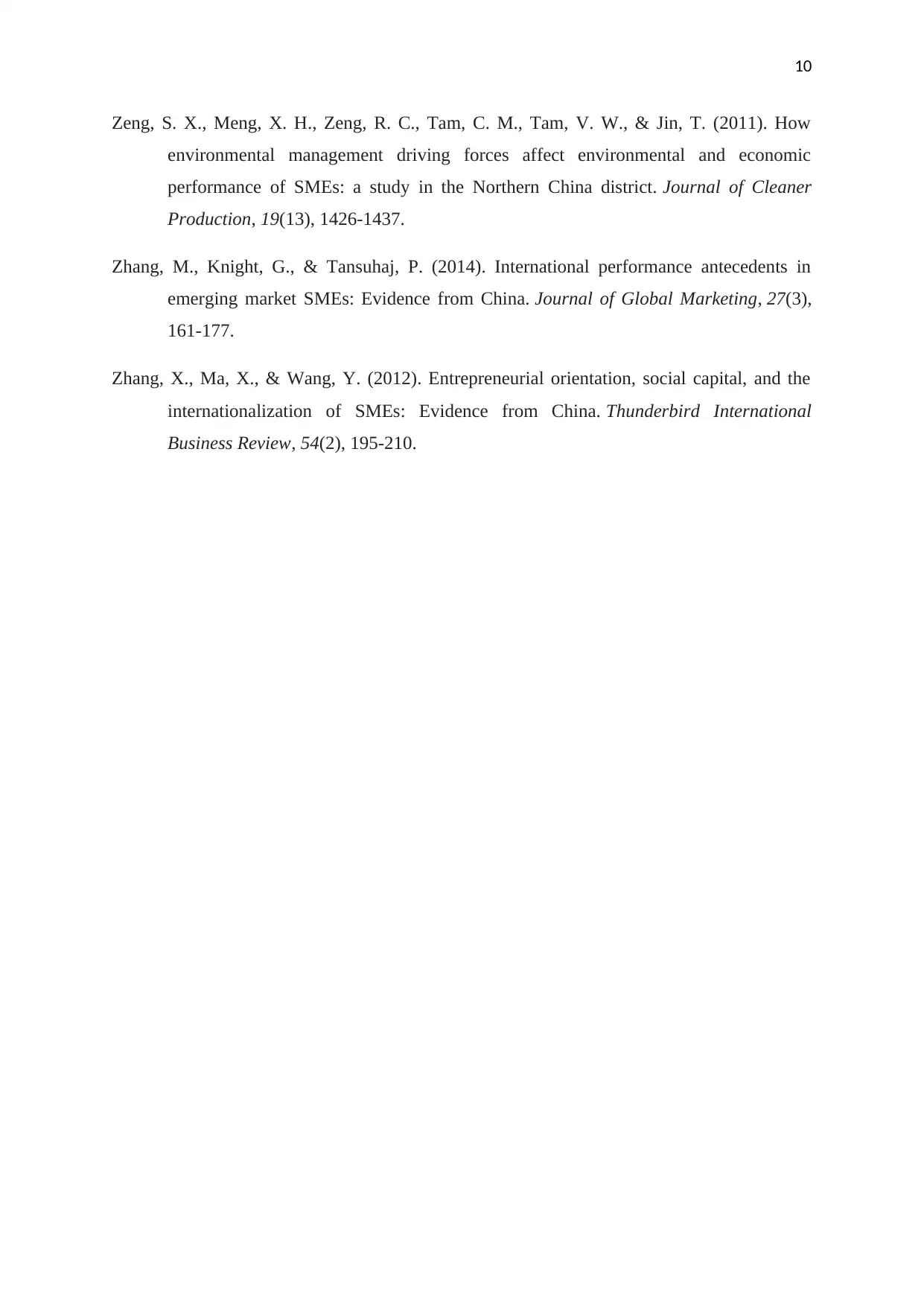
10
Zeng, S. X., Meng, X. H., Zeng, R. C., Tam, C. M., Tam, V. W., & Jin, T. (2011). How
environmental management driving forces affect environmental and economic
performance of SMEs: a study in the Northern China district. Journal of Cleaner
Production, 19(13), 1426-1437.
Zhang, M., Knight, G., & Tansuhaj, P. (2014). International performance antecedents in
emerging market SMEs: Evidence from China. Journal of Global Marketing, 27(3),
161-177.
Zhang, X., Ma, X., & Wang, Y. (2012). Entrepreneurial orientation, social capital, and the
internationalization of SMEs: Evidence from China. Thunderbird International
Business Review, 54(2), 195-210.
Zeng, S. X., Meng, X. H., Zeng, R. C., Tam, C. M., Tam, V. W., & Jin, T. (2011). How
environmental management driving forces affect environmental and economic
performance of SMEs: a study in the Northern China district. Journal of Cleaner
Production, 19(13), 1426-1437.
Zhang, M., Knight, G., & Tansuhaj, P. (2014). International performance antecedents in
emerging market SMEs: Evidence from China. Journal of Global Marketing, 27(3),
161-177.
Zhang, X., Ma, X., & Wang, Y. (2012). Entrepreneurial orientation, social capital, and the
internationalization of SMEs: Evidence from China. Thunderbird International
Business Review, 54(2), 195-210.
1 out of 11
Related Documents
Your All-in-One AI-Powered Toolkit for Academic Success.
+13062052269
info@desklib.com
Available 24*7 on WhatsApp / Email
![[object Object]](/_next/static/media/star-bottom.7253800d.svg)
Unlock your academic potential
Copyright © 2020–2025 A2Z Services. All Rights Reserved. Developed and managed by ZUCOL.





